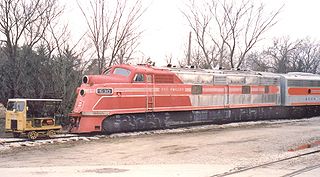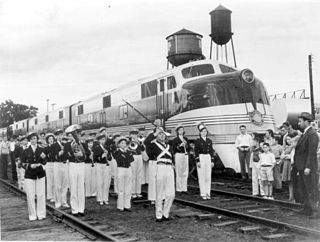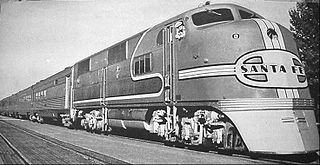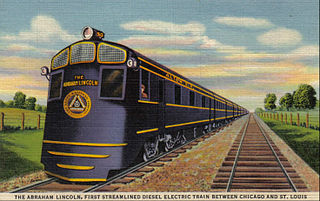
The EMD E5 is a 2,000-horsepower (1,500 kW), A1A-A1A passenger train-hauling diesel locomotive manufactured by Electro-Motive Corporation, and its corporate successor, General Motors' Electro-Motive Division (EMD) of La Grange, Illinois, and produced exclusively for the Chicago, Burlington and Quincy Railroad, and its subsidiaries, during 1940 and 1941. The E5 was distinguished from the otherwise very similar E3, E4 and E6 by being clad in polished stainless steel to match the Burlington's Zephyr trains. It also featured unique small grill-like ornamentation on both sides of the upper headlight. Like the other models in the E-series, the E5 had a sloping “slant nose” and it was equipped with two headlights — a regular stationary headlight above a gyrating Mars signal light. The E5 was the sixth in the EMD E-unit series.

The EMD E6 was a 2,000-horsepower (1,500 kW), A1A-A1A, streamlined passenger train locomotive manufactured by Electro-Motive Corporation, and its corporate successor, General Motors Electro-Motive Division, of La Grange, Illinois. The cab version, E6A, was manufactured from November 1939 to September 1942; 91 were produced. The booster version, E6B, was manufactured from April 1940 to February 1942; 26 were produced. The 2,000-horsepower (1,500 kW) was achieved by putting two 1,000-horsepower (750 kW), 12-cylinder, model 567 engines in the engine compartment. Each engine drove its own electrical generator to power the traction motors. The E6 was the seventh model in a long line of passenger diesels of similar design known as EMD E-units.

The E7 was a 2,000-horsepower (1,500 kW), A1A-A1A passenger train locomotive built by General Motors' Electro-Motive Division of La Grange, Illinois. 428 cab versions, or E7As, were built from February 1945 to April 1949; 82 booster E7Bs were built from March 1945 to July 1948. The 2,000 hp came from two 12 cylinder model 567A engines. Each engine drove its own electrical generator to power the two traction motors on one truck. The E7 was the eighth model in a line of passenger diesels of similar design known as EMD E-units, and it became the best selling E model upon its introduction.

The EMC E4 was a 2,000 horsepower (1,500 kW), A1A-A1A passenger train-hauling diesel locomotive built by the Electro-Motive Corporation of La Grange, Illinois. All were built for the Seaboard Air Line Railway. The E4 was the fifth model in a long line of passenger diesels of similar design known as EMD E-units.

The EMC E3 is a 2,000 horsepower (1,500 kW), A1A-A1A passenger train locomotive that was manufactured by Electro-Motive Corporation of La Grange, Illinois. The EMC demonstrator #822 was released from La Grange for test on September 12, 1938. The cab version, or E3A, was manufactured from September 1938 to June 1940, and 17 were produced. The booster version, or E3B, was manufactured in March 1939 and September 1939, and 2 were produced. The 2,000 hp (1,500 kW) was achieved by putting two 1,000 horsepower (750 kW), 12-cylinder, model 567 engines in the engine compartment. Each engine drove its own electrical generator to power the traction motors. The E3 was the fourth model in a long line of passenger diesels of similar design known as EMD E-units.

The EMC E2 was an American passenger-train diesel locomotive which as a single unit developed 1,800 horsepower (1,300 kW), from two (2) 900 horsepower (670 kW) prime movers. These locomotives were typically operated as a unit set or ; where the three unit lashup developed 5400 horsepower. This was almost the ideal horsepower required for the tonnage of a 15 - 18 car passenger train, operated over the ruling grades of virtually all of the mileage between major American cities. The units were of the A1A-A1A wheel arrangement, and manufactured by Electro-Motive Corporation (EMC), later Electro-Motive Diesel (EMD) of La Grange, Illinois.

The EMC E1 was an early passenger-train diesel locomotive developing 1,800 hp, with an A1A-A1A wheel arrangement, and manufactured by Electro-Motive Corporation of La Grange, Illinois. They were built during 1937 and 1938 for the Atchison, Topeka and Santa Fe Railway for a new generation of diesel-powered streamlined trains. 8 cab-equipped lead A units and three cabless booster B units were built. The initial three locomotives were AB pairs built to haul the Santa Fe's Super Chief diesel streamliners, while the others were built as single A units to haul shorter trains. The locomotives were diesel-electrics with two 900 hp (670 kW) Winton 201-A engines each, with each engine driving its own generator to power the traction motors. The E1 was the second model in a long line of passenger diesels of similar design known as EMD E-units. All Winton 201A-engined Santa Fe passenger units, including the E1s, were extensively rebuilt into the 80-class E8M engines in 1952-53. These were similar to production E8 models, but derated to 2,000 hp so as not to burn out the early traction (axle) motors.

The EMC EA/EB is an early passenger train-hauling diesel locomotive built from May 16, 1937, to 1938 by Electro-Motive Corporation of La Grange, Illinois for the Baltimore and Ohio Railroad. They were the first model in a long line of passenger diesels of similar design known as EMD E-units. Each locomotive unit developed 1,800 horsepower (1,300 kW) from two 900 hp (670 kW) Winton 201-A diesel engines, driving the wheels through an electric transmission—the generator driven by each engine provided current for traction motors. The locomotives were of A1A-A1A wheel arrangement—two three-axle trucks of which only the outer two axles were powered. Six two-unit 3,600 hp (2,700 kW) locomotives were produced, each consisting of a lead cab-equipped EA A unit and a cabless booster EB B unit. They were numbered 51 through 56; the A units bore the bare number and the B units the number followed by 'X'.

The El Capitan was a streamlined passenger train operated by the Atchison, Topeka and Santa Fe Railway between Chicago, Illinois, and Los Angeles, California. It operated from 1938 to 1971; Amtrak retained the name until 1973. The El Capitan was the only all-coach or "chair car" to operate on the Santa Fe main line between Chicago and Los Angeles on the same fast schedule as the railroad's premier all-Pullman Super Chief. It was also the first train to receive the pioneering Hi-Level equipment with which it would become synonymous.

The Pennsylvania Railroad's class O1 comprised eight experimental boxcab electric locomotives built in 1930 and 1931. They were built in preparation for the New York to Washington Electrification project. They had the wheel arrangement classified as 4-4-4 in the Whyte notation. Although successful, they were not powerful enough for the railroad's increasingly heavy trains. For production, the PRR chose to concentrate on the P5 class, effectively an enlarged and more powerful version of the O1 with an additional pair of driving wheels.

The Abraham Lincoln was a named passenger train operated by the Baltimore and Ohio Railroad from 1935 into the 1960s. The Abe Lincoln ran between Chicago and St. Louis on the B&O's subsidiary Alton Railroad. The train later passed to the Gulf, Mobile and Ohio Railroad, and then finally to Amtrak, which retained the name until 1978. Service between Chicago and St. Louis is now known by the umbrella term Lincoln Service. This train was the first streamlined passenger service to travel the 284 miles between Chicago and St. Louis, with Joliet, Bloomington-Normal, Springfield and Alton in between. Passengers can get a glimpse of the Mississippi River between Alton and St. Louis.

The James Whitcomb Riley was a passenger train that operated between Chicago, Illinois, and Cincinnati, Ohio, via Indianapolis, Indiana. Originally operated by the New York Central Railroad, it was taken over by Amtrak in 1971. Under Amtrak, it merged with the Chesapeake & Ohio Railway's George Washington to become a Chicago-Washington/Newport News train. In 1977, it was renamed the Cardinal, which remains in operation.
The Bankers was a passenger train operated by the New York, New Haven and Hartford Railroad between Grand Central Terminal, New York City and Springfield, Massachusetts. Under the New Haven the Bankers provided early morning express service from Springfield to New York, running non-stop from New Haven, Connecticut. The Bankers was paired with the Nathan Hale, which ran an hour later. In the afternoon the train returned as the Connecticut Yankee. The Bankers carried parlor cars, a grill (dining) car and coaches.

The Ohio State Limited was a named passenger train operated by the New York Central Railroad (NYC) between New York City and Cincinnati, Ohio, via Buffalo and Cleveland, Ohio. Service began in 1924 and continued until 1967, with some vestiges remaining until 1971.

The Blue Bird was a streamlined passenger train operated by the Wabash Railroad and its successor the Norfolk and Western Railway between Chicago, Illinois, and St. Louis, Missouri. It operated from 1938 to 1971. Beginning in 1950 it was one of the few Wabash passenger trains to carry a dome car and the first dome train in regular operation between the two cities. The train was cut back to Decatur, Illinois, in 1968 and renamed City of Decatur. Amtrak did not retain the City of Decatur, and it made its last run on April 30, 1971.

The Streamliners were a fleet of three streamlined electric multiple units built by the St. Louis Car Company for the Illinois Terminal Railroad in 1948–1949. They operated primarily between St. Louis, Missouri and Peoria, Illinois in the late 1940s and early to mid-1950s. They were the last interurban cars manufactured in the United States.
William D. Middleton was an American reporter, writer and photographer. The majority of his work was on the subject of railroad history and operation. He published over 20 books and approximately 700 articles for magazines and newspapers, accompanied by photographs. His work as a photographer was profiled in the Spring 2011 issue of Classic Trains magazine.














